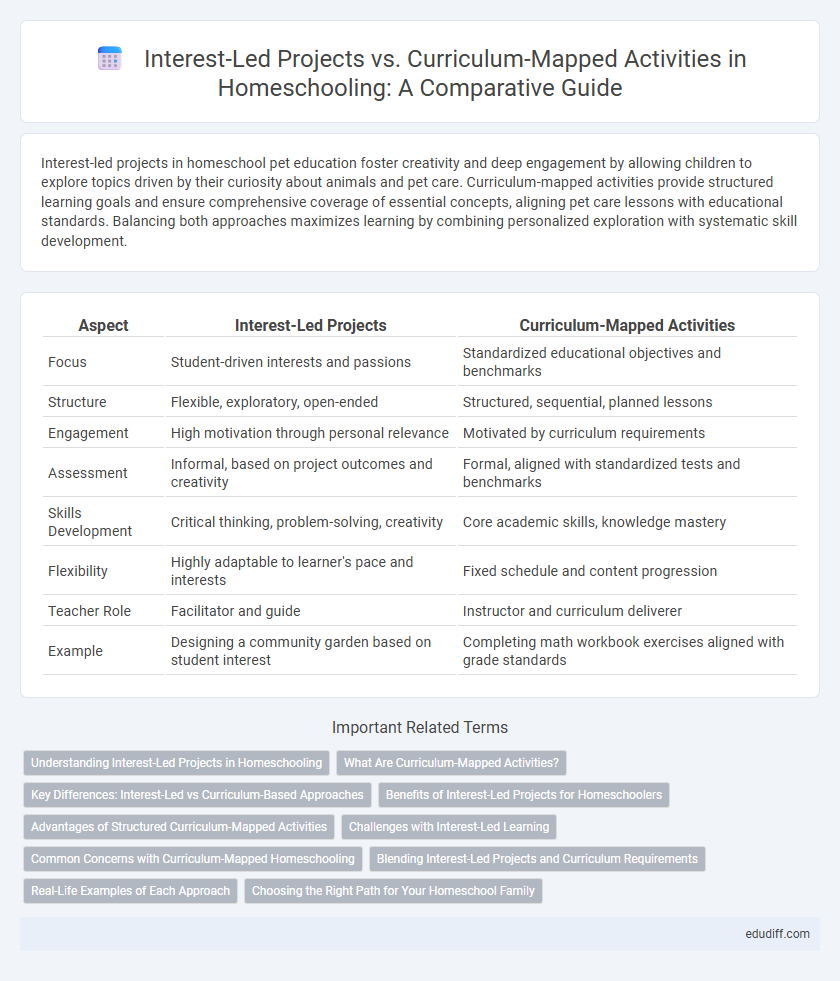Interest-led projects in homeschool pet education foster creativity and deep engagement by allowing children to explore topics driven by their curiosity about animals and pet care. Curriculum-mapped activities provide structured learning goals and ensure comprehensive coverage of essential concepts, aligning pet care lessons with educational standards. Balancing both approaches maximizes learning by combining personalized exploration with systematic skill development.
Table of Comparison
| Aspect | Interest-Led Projects | Curriculum-Mapped Activities |
|---|---|---|
| Focus | Student-driven interests and passions | Standardized educational objectives and benchmarks |
| Structure | Flexible, exploratory, open-ended | Structured, sequential, planned lessons |
| Engagement | High motivation through personal relevance | Motivated by curriculum requirements |
| Assessment | Informal, based on project outcomes and creativity | Formal, aligned with standardized tests and benchmarks |
| Skills Development | Critical thinking, problem-solving, creativity | Core academic skills, knowledge mastery |
| Flexibility | Highly adaptable to learner's pace and interests | Fixed schedule and content progression |
| Teacher Role | Facilitator and guide | Instructor and curriculum deliverer |
| Example | Designing a community garden based on student interest | Completing math workbook exercises aligned with grade standards |
Understanding Interest-Led Projects in Homeschooling
Interest-led projects in homeschooling center on a child's natural curiosities, fostering deeper engagement and personalized learning experiences tailored to their passions. This approach contrasts with curriculum-mapped activities that follow predetermined standards and objectives, often limiting flexibility and creativity. Emphasizing interest-led projects encourages intrinsic motivation, critical thinking, and real-world application of knowledge within a supportive, adaptable learning environment.
What Are Curriculum-Mapped Activities?
Curriculum-mapped activities are structured learning tasks designed to align with specific educational standards and learning objectives outlined in a curriculum framework. These activities provide a systematic approach that ensures coverage of essential skills and knowledge across subjects, facilitating measurable progress over time. By following a curriculum map, educators and homeschool parents can maintain consistent, goal-oriented instruction tailored to meet academic benchmarks.
Key Differences: Interest-Led vs Curriculum-Based Approaches
Interest-led projects prioritize student curiosity and intrinsic motivation by allowing learners to explore topics based on their personal interests, fostering creativity and deeper engagement. Curriculum-mapped activities follow a structured framework aligned with educational standards, ensuring comprehensive coverage of required skills and knowledge. The key difference lies in flexibility, where interest-led approaches adapt to the learner's pace and preferences, while curriculum-based methods emphasize consistency and measurable progress through predefined learning objectives.
Benefits of Interest-Led Projects for Homeschoolers
Interest-led projects empower homeschoolers by fostering intrinsic motivation and deepening engagement through personalized learning experiences that align with their passions. These projects promote critical thinking, creativity, and problem-solving skills by allowing students to explore topics in-depth rather than follow a rigid, predetermined curriculum. This approach enhances retention and cultivates a lifelong love of learning by making education relevant and meaningful to individual interests.
Advantages of Structured Curriculum-Mapped Activities
Structured curriculum-mapped activities ensure consistent coverage of essential academic standards and provide measurable learning outcomes that align with educational benchmarks. These activities facilitate systematic skill development and progress tracking, which supports long-term academic success and readiness for standardized assessments. Clear guidelines and targeted objectives help parents and educators maintain focus and deliver a comprehensive education tailored to student needs.
Challenges with Interest-Led Learning
Interest-led learning in homeschooling often faces challenges such as inconsistent progress tracking and difficulty aligning with standardized educational goals. Students may struggle with staying motivated when interests shift frequently, leading to gaps in foundational knowledge. Parents and educators must balance fostering curiosity with ensuring comprehensive skill development and meeting curriculum requirements.
Common Concerns with Curriculum-Mapped Homeschooling
Curriculum-mapped homeschooling often faces challenges such as limited flexibility, which can stifle a child's natural curiosity and creativity. Teachers may struggle to adapt rigid lesson plans to accommodate individual learning paces and interests, potentially leading to decreased student engagement. Concerns also include the risk of overlooking diverse learning styles and the pressure on parents to strictly adhere to standardized educational goals without room for personalized exploration.
Blending Interest-Led Projects and Curriculum Requirements
Blending interest-led projects with curriculum requirements creates a dynamic homeschooling environment that fosters both student engagement and academic rigor. By aligning student passions with mandated learning outcomes, parents can craft customized lessons that motivate deeper understanding and skill mastery. This approach balances creativity and structure, ensuring educational goals are met while nurturing intrinsic motivation and critical thinking.
Real-Life Examples of Each Approach
Interest-led projects in homeschooling often include real-life examples such as a child creating a mini-business to learn entrepreneurship or conducting a garden experiment to explore biology concepts. Curriculum-mapped activities typically follow structured frameworks, like completing assigned math worksheets aligned with grade-level standards or following a science textbook's step-by-step lab experiments. These examples highlight how interest-led learning fosters creativity and personalized engagement, while curriculum-mapped tasks ensure comprehensive coverage of academic objectives.
Choosing the Right Path for Your Homeschool Family
Interest-led projects empower homeschool families to tailor learning experiences based on children's passions, fostering intrinsic motivation and creativity. Curriculum-mapped activities provide structured, standards-aligned content that ensures comprehensive skill development and academic consistency. Selecting the right approach depends on balancing personalized engagement with educational goals to optimize each child's growth and achievement.
Interest-Led Projects vs Curriculum-Mapped Activities Infographic

 edudiff.com
edudiff.com